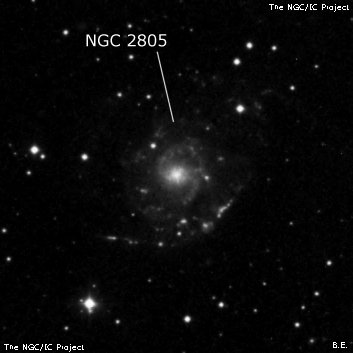
William Herschel discovered NGC 2805 = H III-878 on 2 Apr 1791 (sweep 1000) and recorded "vF, cL, R, vF, mbM. I suppose it to be near 5' in diam but is so faint on the outside that it is difficult to determine its extent." His position and description matches UGC 4936 = PGC 26410.
400/500mm - 17.5" (4/6/91): faint, large, irregularly round, very low surface brightness, weak concentration but no nucleus. Located at the west end of a string of 7 mag 13-14 stars. Several brighter stars are in the field including mag 9 SAO 14844 6.5' NNW and a mag 10 star 4.4' SE. Largest of four in a group including NGC 2814 11' NE, NGC 2820 and IC 2458 13' NE.
600/800mm - 24" (2/22/14): moderately bright, very large, contains a 30" brighter core and a huge halo extending up to 4'x3' NW-SE. The halo has a fairly low surface brightness but is slightly mottled, hinting of HII regions [SDSS shows a string of HII knots along the outer southern arm]. A mag 12.5 star is just off the NW edge of the halo and a mag 14 star is on the NE side. Largest in a group (LGG 173) including the trio NGC 2814, IC 2458 and NGC 2820, roughly 10' NE.
Notes by Steve Gottlieb